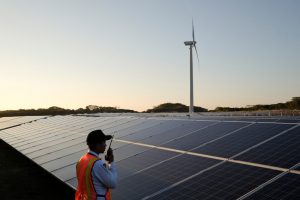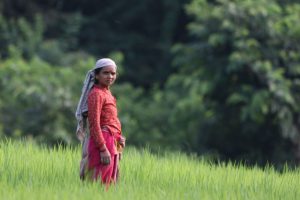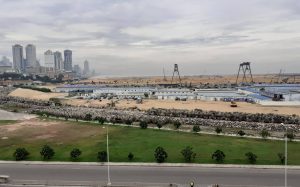When the Intergovernmental Panel on Climate Change (IPCC) released the Special Report on 1.5 degrees (SR 1.5) in 2018, climate change activists pressed on policymakers to go beyond words of concern and undertake concrete action. SR 1.5 painted a dire picture of a world in which average global temperature has already increased by over 1 degree Celsius over pre-industrial levels (mid-1800s). The environmental impacts of human-induced climate change are already being felt, most acutely at the moment by fragile ecosystems such as coral reefs and mangrove forests. The report warns us that the world is at risk of losing its coral reefs if the temperature rise continues unabated. It is also a strident call for action – if we do not start reversing the trend by 2030 – capping global warming at 1.5 degrees, it may be too late.
But climate change and environmental protection policies remain mired in geo-politics. As described by Peter Smith, one of the lead authors of the recent IPCC Special Report on Climate Change and Land, negotiations range over data, analysis, recommendations and even syntax. In such negotiations, which surely must be bruising experiences for the authors, countries often take dogged positions that result in path-breaking proposals being either dropped or massively diluted.
After US President Donald Trump’s decision to pull his country out of the 2015 Paris Climate Agreement, the starkest example of such obstruction came in June 2019, when Saudi Arabia forced the United Nations Framework Convention on Climate Change (UNFCCC) to drop all references to SR 1.5 from global climate negotiations.
Nevertheless, globally, the science of climate change has advanced tremendously, and there is a consistent and urgent need for all of us to act on this knowledge.
The reactions to the passionate activism of young climate activist Greta Thunberg shows just how divisive such calls for action can be. But what is clear is this – we cannot sit around waiting for others to act. The United States seem to have taken a step backwards, exiting the financing commitments it has made to the developing world, and at the federal level reducing its commitment to tackle climate change. China, on the other hand, has taken significant steps towards addressing the emissions from its manufacturing sector supply chains. India too has made significant progress on the renewable energy front, a critical sector in a rapidly-developing, energy-hungry country.
The Bangladesh model
During 2016-18, I was involved in a research and policy advocacy programme on ‘green growth’ (or environmentally-responsible growth) in Bangladesh, a country severely vulnerable to the destructive impact of intensified natural hazards and accelerating deterioration of the environment caused by climate change. Bangladesh has sustained an impressive growth trajectory over the last decade, having now emerged as the fastest-growing economy in South Asia. This growth remains vulnerable to scarcity of natural resources, environmental degradation, population pressure, widening economic inequality and so on. This has in turn put pressure on policymakers to rethink growth strategies to ensure sustainability.
We regularly brought together a wide range of stakeholders – government officials, regulators, private sector entrepreneurs, activists, media, and the research and academic community – to recognise the gaps in knowledge and chart a joint agenda for Bangladesh. Research conducted as part of this programme directly responded to the priorities outlined by the government as well as the private sector, drawing out key inputs for improved policymaking.
The conversations were often difficult, as Bangladesh is a country with very passionate climate activists from all walks of life as well as those trying to find a balance between the currently-adopted path of economic growth and environmental protection. Politicians, while being committed to the idea of Sonar Bangla (Golden Bengal) would rightly ask who exactly was responsible for climate change, and why the rich countries weren’t paying more in terms of funds and technology transfer. They wondered about the equity implications of focusing on the environment at the cost of forgoing immediate opportunities of economic growth, and what the sequence of policy moves need to be, to tackle climate change.
But all along, there was an acknowledgement of the need to do more, and politicians took great pride in the way Bangladesh was leading the way in generating knowledge on adaptation, mitigation as well as emergency response and recovery that could be transferred to other countries – both rich and poor.
A few factories show the way
In Bangladesh (and in several developing countries), the role of the private sector in leading action on climate change is crucial. For example, ready-made garments (RMG) is a vital sector, making up for over 80% of Bangladesh’s exports to the outside world, and intricately linked in to the global RMG value chain. The RMG and leather manufacturing sectors are also amongst the most polluting industries. Voluntary compliance in these sectors that goes above and beyond the legally required standards can make a significant difference to the environment in Bangladesh. From our research, we identified several cases where the best-performing factories demonstrated levels of environmental responsibility far higher than what is required by the government. Our research studied the drivers of such positive deviance, and the role of internal and external factors that contributed to this behaviour.
The lessons from this research, and the potential role of upstream players in the global RMG value chain (buyers and brands) are highly relevant for Bangladesh, as well as for other manufacturing-focused countries around the world.
Follow the demand
Another area of action is finance – particularly government regulation and public-private-partnerships (PPP). ‘Green finance’ is a good example of such collaboration. We studied the central bank’s ‘green banking’ policies, helping to bridge the communication gap between the central bank and financial institutions on the ground that were struggling to meet the green finance disbursement quota set by central bank. Our research highlighted the challenges faced by financial institutions to disburse green finance. It also highlighted the importance of designing a demand-driven approach, rather than persisting with the government’s policy-driven (supply-driven) finance that is currently in place.
The nature of financing that would fuel the growth of green businesses is quite specific. Such finance must have three essential qualities: it must demonstrate a high risk-appetite; it must be scalable and responsive to the needs of the industry; and it must focus on long-term impact. While there will always be a prominent role for government regulation when it comes to green finance, especially in terms of setting standards and oversight, it is imperative that the sector responds to the needs of green businesses and entrepreneurs in the country.
From dialogue to action
Promoting dialogue on climate change is essential. Due to the momentum generated by scientists and activists, this is relatively straightforward too. Taking concrete action is harder, and this is where political economy considerations become crucial. Moving from dialogue and deliberation to policy reform and then to action is not a linear process. In much of the world, the private sector has a critical role to play, working with governments in being at the forefront of tackling environmental degradation. Several countries across the world may be hamstrung when it comes to tackling the destructive effects of climate change, but are surely capable of limiting the environmental damage they cause through domestic economic policies. In responding to the calls for action, it is thus vital for countries to look within.
Suvojit Chattopadhyay works with Adam Smith International and was involved in the implementation of UK DFID-funded Economic Dialogue on Green Growth, a policy research and advocacy project in Bangladesh
![<p>CO2 emissions by type of coal plant [Source: NRDC]</p>](https://dialogue.earth/content/uploads/2019/03/graph4_cropped.png)







